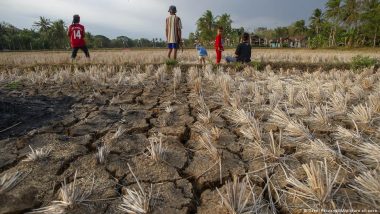Dangerous temperatures, intensified by El Nino, have forced authorities across Southeast Asia to issue heat warnings and close schools. Here's why El Nino and its sibling, La Nina, have such far-reaching weather impacts.As soaring temperatures continue to grip Southeast Asia, many authorities have issued extreme heat warnings including in Thailand, where heatstroke is reported to have killed 30 people so far this year.
Also Read | India News | Lok Sabha Phase-2: 94-year-old Woman Walks to Polling Booth to Cast Vote in Manipur.
Schools across the region have been forced to close — including in Bangladesh, where an estimated 33 million children have been impacted. In the Philippines more than half of the country's provinces are experiencing drought.
Also Read | World News | Urgent Reforms Imperative to Make UN Reflective of Current Geopolitical Realities: India.
This El Nino cycle, which scientists say began around June and peaked in December before starting to wane, is behind extreme heat and drought in the region. Asia is warming faster than the global average and in 2023 was the world's most disaster hit region from weather and climate events.
But El Nino is also wreaking havoc across Africa.
On April 4, the president of Zimbabwe, Emmerson Mnangagwa, declared a "State of Drought Disaster" due to the "severe food situation caused by the El Nino effect."
Zambia and Malawi had already declared a disaster as El Nino-driven drought continued to devastate crops across southern Africa.
The Pacific Ocean weather phenomenon, El Nino — "the little boy" in Spanish — is linked to record global temperatures in 2023 that amounted to the hottest year on record.
Its "little girl" sister, La Nina, creates weather patterns that, although variable, tend to be wetter and lead to intense storms and hurricanes.
How El Nino causes weather extremes
The El Nino weather phase is part of the so-called El Nino-Southern Oscillation (ENSO), a climate pattern triggered in the Pacific Ocean.
El Nino commonly occurs every two to seven years when regular trade winds moving east-west across the Pacific weaken and sometimes even reverse.
These winds usually blow across the equator and take warm water from South America toward Southeast Asia and Australia.
But, when the winds start to calm, the warmer water remains in South America and fails to travel west. As the warmth suppresses the usual upwell of cold water in the eastern Pacific, extra heat in the atmosphere typically supercharges regional rainfall and causes flooding in northern South American countries such as Bolivia.
Meanwhile, the absence of warm water in the western Pacific can result in drought and extreme temperatures.
Though predictions of a nightmare fire season in Australia in the summer of 2023-24 at the peak of the El Nino cycle did not come to pass, August through October were still the driest months in 120 years.
El Nino's disruption of ocean heat can alter the path of jet streams — strong winds far above the ground — that travel the planet, guiding rains. This causes broad climate disruption, including the stalling of the monsoon in Indonesia and India, but also the reduction of hurricane activity in the Atlantic.
Furthermore, El Nino was partly to blame for heavy rains and flooding in East Africa in late 2023. By late last year, floods had killed at least 120 people and displaced 700,000 residents in Kenya.
Though researchers have found that the direct impact of El Nino on rainfall in eastern African is relatively modest, they say it can kick-start a positive Indian Ocean Dipole, another climate pattern that is bringing extreme flooding to the region.
La Nina fuels storms and hurricanes
La Nina, another key phase in the ENSO, has the opposite impact from El Nino as predominant east-west winds become stronger than usual.
An increase of warmer water in the west brings increased rainfall to Australia and Southeast Asia.
La Nina phases can spark drought and wildfires in eastern Pacific regions from southwestern United States and Mexico through to South America. However, regional variability means that northeast US states and Canada tend to be wetter and colder during La Nina winters.
La Nina also typically enhances hurricane activity in the Atlantic Basin, a phenomenon that is being exacerbated by record warm ocean surface temperatures in the Atlantic.
Impacts are hard to predict
Though La Nina and El Nino are natural patterns, their relative impacts can vary depending on their timing, duration and complex climate influences that include human-induced global heating.
There is some evidence that climate change has made ENSO events more frequent and intense.
Scientists have said El Nino and La Nina cycles are likely to hit harder as the planet heats up. Hotter air holds more water and causes more extreme rainfall.
Researchers add that achieving net-zero greenhouse gas emissions through the phasing out of fossil fuels has the potential to limit both global heating and ENSO impacts.
Edited by: Tamsin Walker
This article was updated on April 26 to include information about the ongoing heatwave in Southeast Asia.
Sources
US National Environmental Education Foundation, "El Niño and La Niña: What’s the Difference?"
https://www.neefusa.org/story/climate-change/el-nino-and-la-nina-whats-difference
World Food Programme, "WFP urges global support as Malawi faces looming food crisis triggered by El Niño," April 2, 2024
https://www.wfp.org/news/wfp-urges-global-support-malawi-faces-looming-food-crisis-triggered-el-nino
Climate Council, "Spring Heatwave and Sweltering El Niño Summer Ahead Reignites Call for Net-Zero Emissions By 2035," September 20, 2023
https://www.climatecouncil.org.au/resources/spring-heatwave-and-sweltering-el-nino-summer-ahead-reignites-call-net-zero-emissions-2035/
(The above story first appeared on LatestLY on Apr 26, 2024 05:50 PM IST. For more news and updates on politics, world, sports, entertainment and lifestyle, log on to our website latestly.com).













 Quickly
Quickly


















